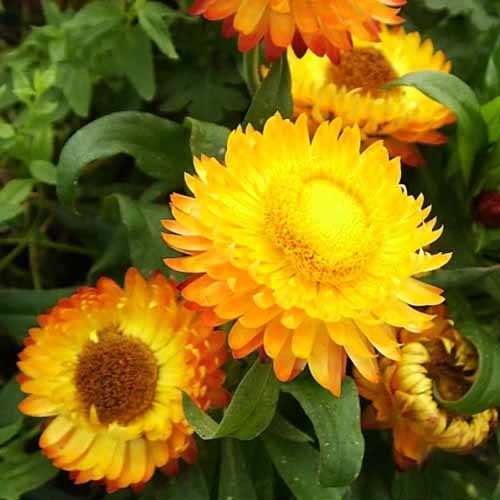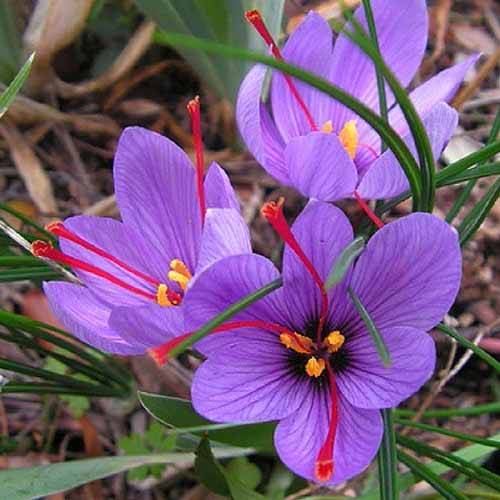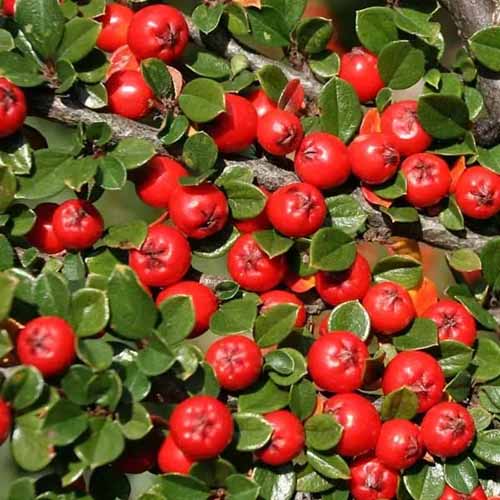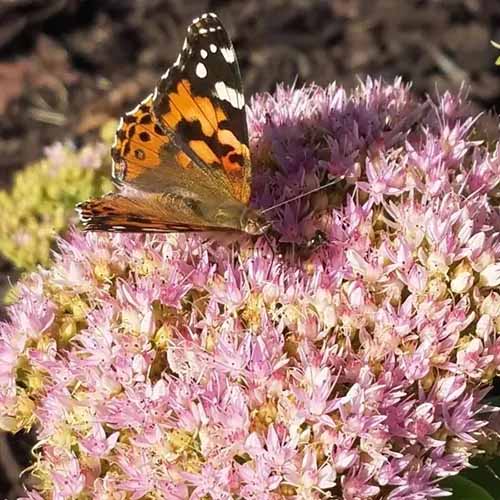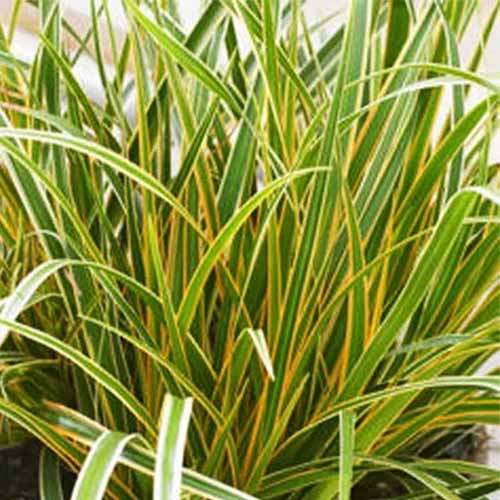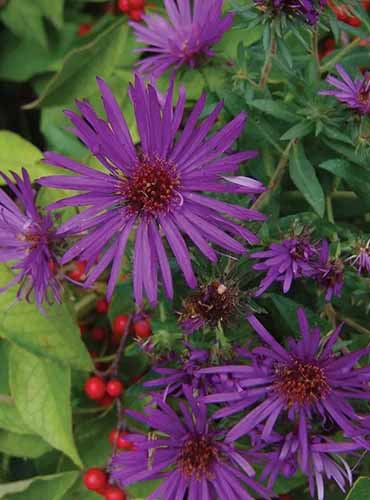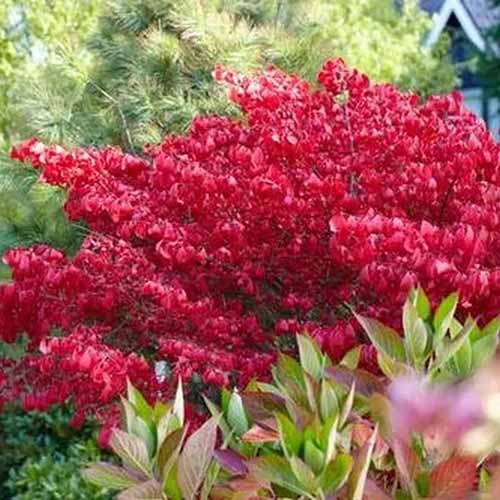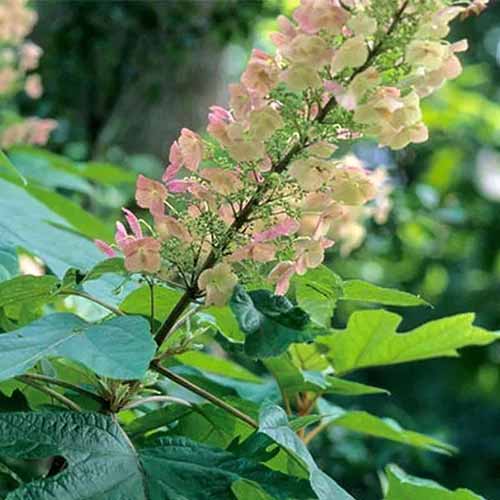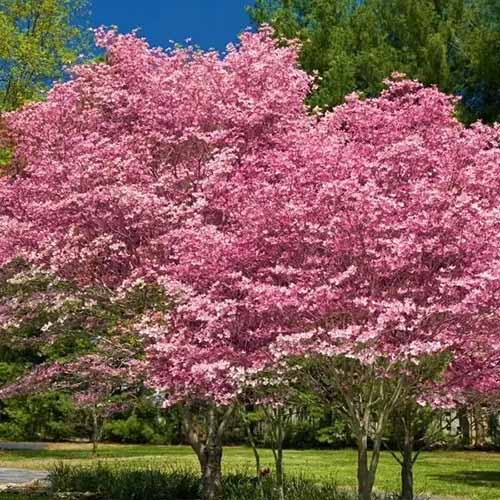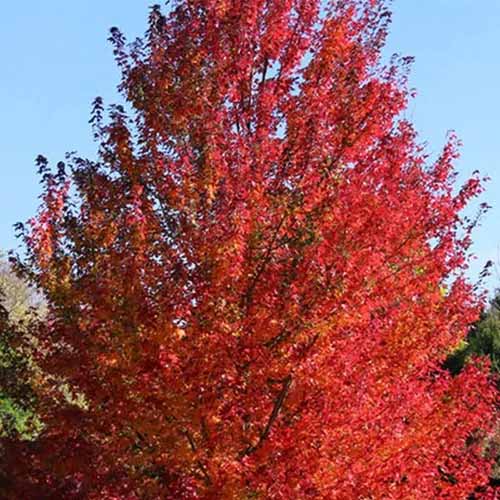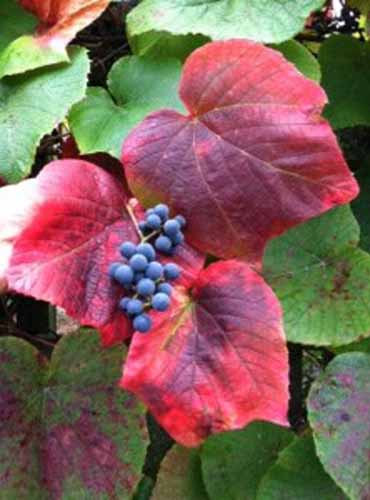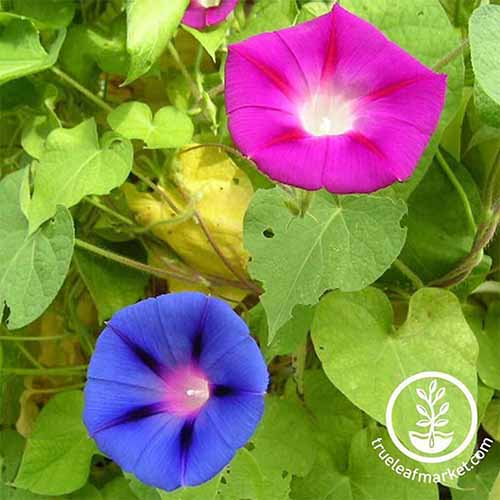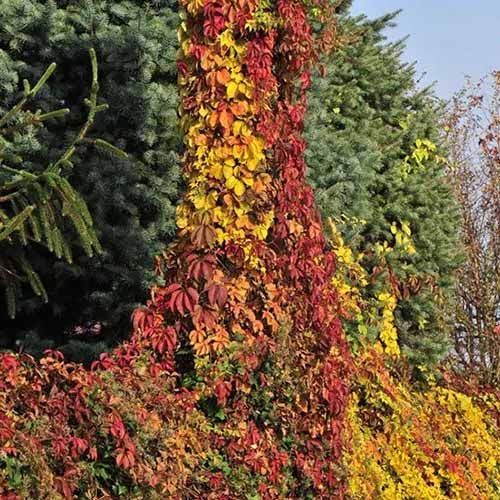Fall color is a feast for the eyes. After a hazy, humid summer of pastel blooms, a refreshing chill in the air sets the landscape ablaze with the boldest, brightest hues of the year.

We link to vendors to help you find relevant products. If you buy from one of our links, we may earn a commission.
Shades of brown, gold, orange, pink, purple, red, yellow, and white mix and mingle, creating a rich tapestry that glows brilliantly on crisp, sunny days.
This article showcases a variety of plants with outstanding fall colors that you can incorporate into your outdoor living space to celebrate autumn in all its glory.
Here’s our lineup:
Add Vibrant Color to the Fall Landscape
Let’s jump right in!
Annuals
Choose annuals that bloom from summer to frost or cool-weather varieties you can pop in after the heat of summer subsides.
1. Celosia
Suited to USDA Hardiness Zones 9 to 11, celosia, aka cockscomb (Celosia spp.), sports velvety, flame-like plumes in maroon, orange, pink, purple, red, yellow, and white shades.
Attaining heights of 18 to 24 inches, foliage ranges from green to burgundy and gold.
The height is just right for middle placements in beds, borders, and containers.
Red celosia is 14 to 16 inches tall with scarlet plumes and bronze foliage. Seeds are available from True Leaf Market.
See our guide to growing celosia for more information.
2. Pansy
The pansy, Viola x wittrockiana, prefers cool fall and spring weather. It’s a perennial in Zones 6 to 10, with winter protection being beneficial in the coldest regions.
However, we include it here because many grow it as an annual, popping plants in the ground in late winter for a spring display or in early fall for pumpkin season.
Mature heights are a petite six to nine inches. Colors include blue, maroon, orange, pink, purple, red, yellow, and white, as well as bicolor combinations.
Their low profile makes pansies a good choice for front-of-bed placements, containers, edging, and window boxes.

Pansies are also well-suited to planting over spring-flowering bulbs, so consider this placement if garden space is an issue.
Swiss Giants Mix pansies are available from the Ohio Heirloom Seeds Store via Amazon.
The flowers feature vibrant shades of blue, purple, red, white, and yellow single and bicolor blossoms on four- to 10-inch stems.
Our guide to growing pansies have all you need to know to grow your own.
3. Strawflower
The strawflower, Xerochrysum bracteatum, is like a crisp daisy, with its paper-like bracts around a center disk.
It grows as an annual in Zones 2 to 7 and a short-lived perennial in Zones 8 to 10.
It’s available in shades of lavender, peach, pink, purple, white, and yellow, with heights of 15 to 40 inches, depending on the cultivar.
Mass planting yields swaths of color that anchor the backs of garden beds and fill meadows and drifts with blooms from summer to frost.
The straw-like bracts of ‘Golden Yellow’ are yellow with orange undersides.
These plants may reach heights of 40 inches.
‘Golden Yellow’ strawflower seeds are available from Eden Brothers.
See our guide to growing strawflowers for details.
Berry-Bearers
Berries in shades of blue, purple, red, and white are a stand-out sensation in the late-season landscape.
4. American Beautyberry
Suited to Zones 5 to 10, American beautyberry, Callicarpa americana, is suited to Zones 5 to 10 and grows between six and 10 feet tall.
Japanese beautyberry, Callicarpa japonica, grows in Zones 5 to 8 and reaches heights of four to six feet.
Both have chartreuse foliage and magnificent clusters of bright purple berries that are a favorite of foraging wildlife.
The American variety is larger in stature, with a more upright growth habit, bigger leaves, and clusters of berries nestled against the branches.
You can find American beautyberry available in three-gallon pots from Fast Growing Trees.
The Japanese type is shorter with smaller foliage and loose clusters of berries set away from the branches.
Group the shrubs for a strong visual impact along foundations and perimeters. Place them behind smaller flora to anchor beds.

The four- to six-foot non-native Japanese beautyberry offers a more compact specimen which may meet the needs of gardeners adding to established landscapes in Zones 5 to 8.
Japanese beautyberry is available from DAS Farms via Amazon.
See our beautyberry growing guide for complete information.
5. Scarlet Firethorn
Scarlet firethorn, Pyracantha coccina, thrives in Zones 6 to 9 and reaches heights of six to 18 feet. It’s a thorny haven for birds that puts on a spectacular show of orange berries in the fall.
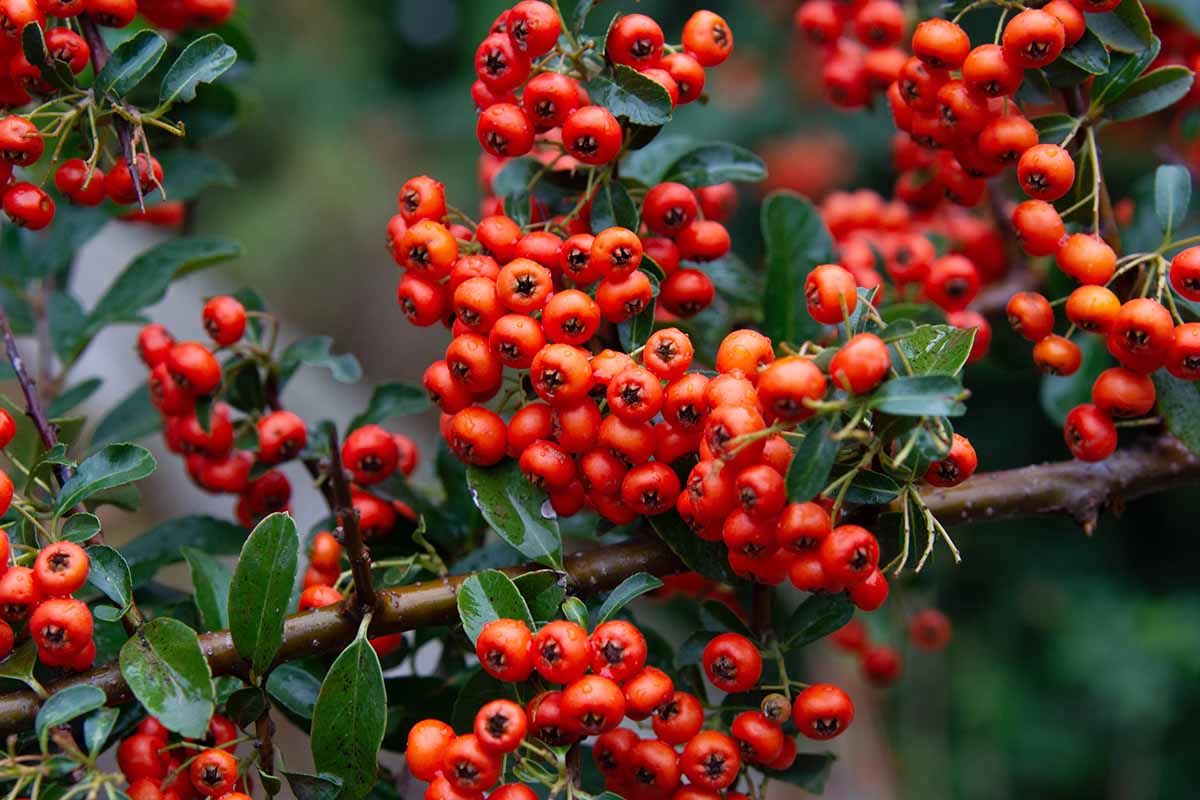
Use it as a stand-alone specimen, as part of a property perimeter hedge, or in a mixed shrub grouping to show off its seasonal color.
6. Viburnum
Suited to Zones 2 to 8, viburnum, Viburnum spp., is available in heights ranging from two to 30 feet.
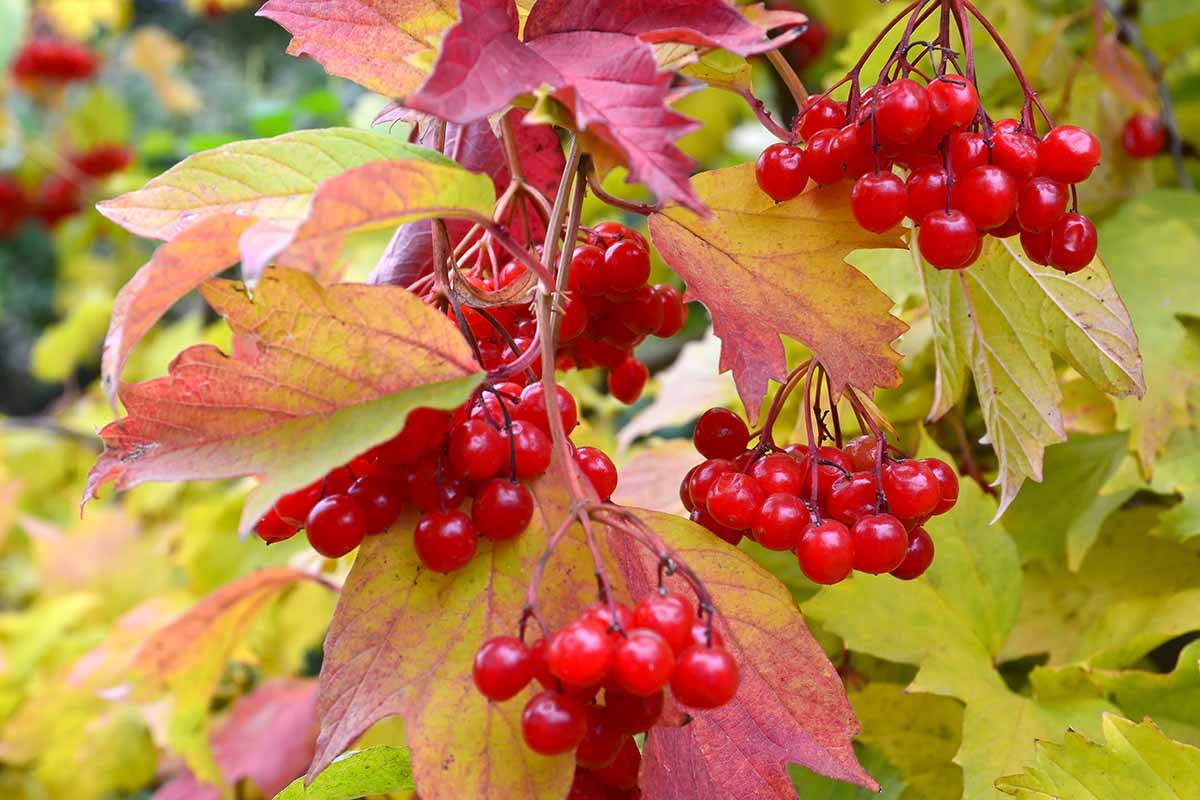
When the foliage changes to shades of orange, purple, red, and yellow, the branches are laden with clusters of black, blue, pink, purple, or red berries, depending upon the cultivar.
Viburnum makes an outstanding focal specimen grouped with smaller plants or standing alone. It’s a magnet for migrating birds of the season.
Learn more about viburnum care here.
Bulbs
As mentioned, bulbs are easily planted below shallow-rooted plants, doubling the planting capacity of each square foot of soil.
7. Autumn Crocus
Pink or purple autumn crocus, Crocus sativus, aka saffron crocus, is suited to Zones 4 to 8.
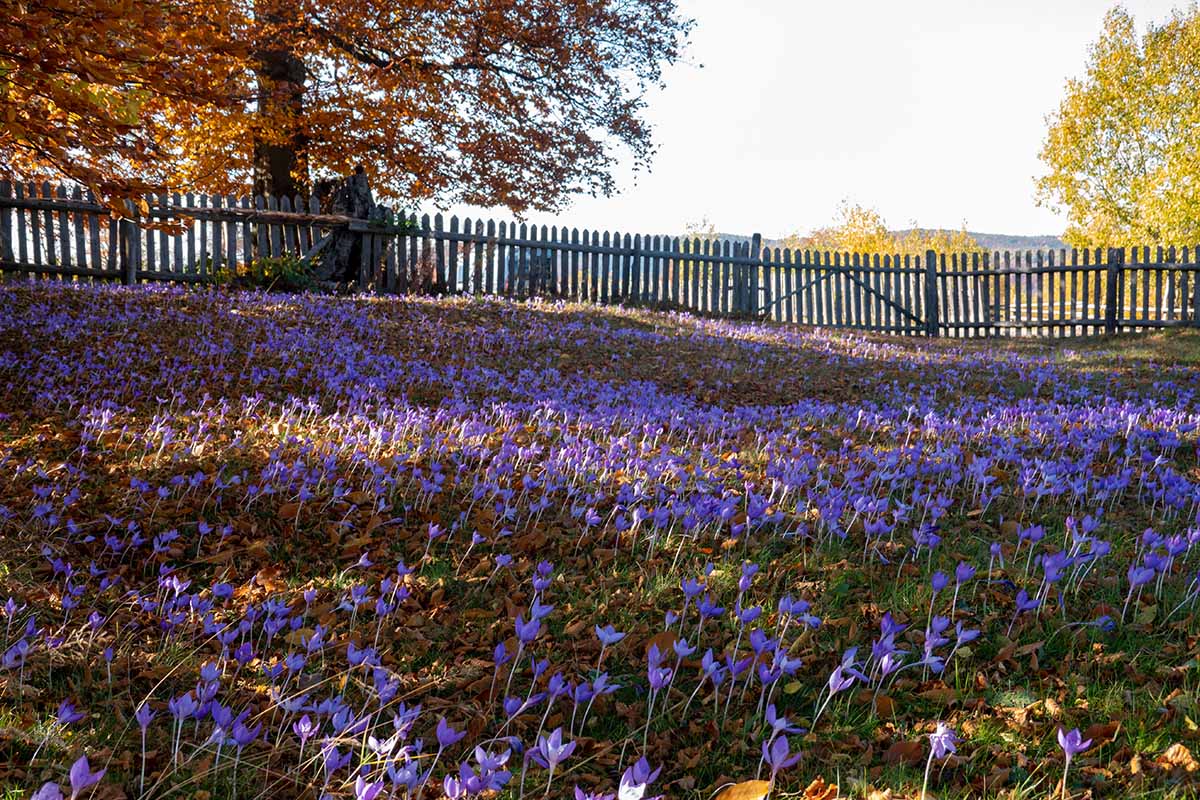
They reach a petite six to 12 inches tall. Cultivars sport white throats and single or double petals.
Scattered among a lawn littered with golden leaves, they are harbingers of winter and a different species than the early crocuses of spring, C. chrysanthus and C. vernus.
These blue-violet flowers are especially attractive in the fronts of beds and borders. They play well with native New England and New York asters of similar hues, Zone 4 to 8 companions.
Note that the attractive elongated red stigmas are edible saffron threads.
Autumn crocus bulbs are available from Eden Brothers.
Learn more about how to grow crocus in our guide.
Other flowers commonly called “autumn crocus” belong to the Colchicum genus.
Not true crocuses, they resemble them in color and fall bloom time, but are toxic and do not contain saffron.
You can read about Colchicum autumn crocuses here.
8. Cyclamen
Potted in all zones and suitable for year-round cultivation in the ground in Zones 9 to 11, cyclamen, Cyclamen spp., grows from flattened tubers and achieves a mature height of six to 14 inches, depending upon the type.
Choose from bicolor, pink, purple, red, and white. Green and silver foliage provides added visual interest.
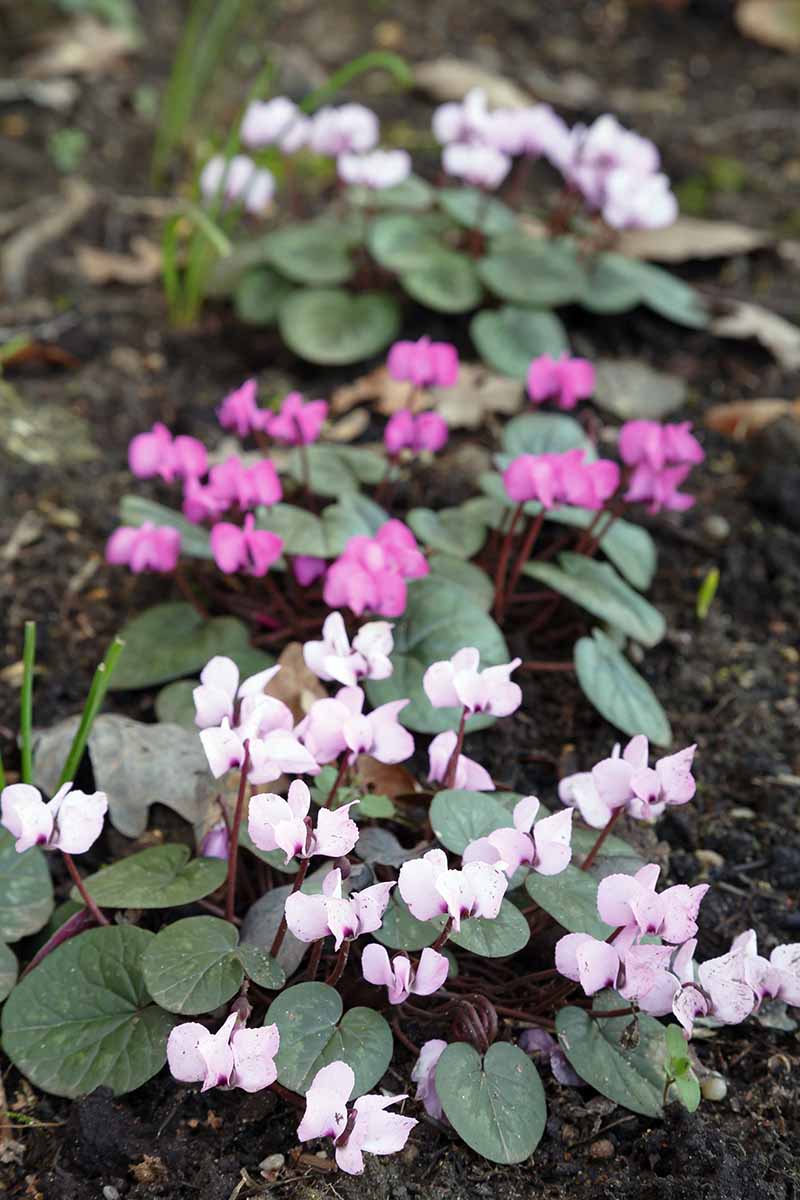
Plants are readily available in nurseries in season.
The flowers bloom during the cooler weather of fall, winter, and spring. Container and edging placements show them to best advantage.
If you live in a cool zone with freezing winters, like me, you can grow yours in pots and bring them indoors for the winter.
See our cyclamen growing guide for details.
9. Dahlia
For gorgeous blooms from midsummer to fall, you can’t beat dahlias (Dahlia spp.).
Botanically herbaceous perennials, they grow from tubers that gardeners in cooler climes lift and store for the winter. Plants can overwinter in the ground in Zones 8 to 11.
Heights range from nine to 60 inches, depending on the variety.
Single and lush double blooms are available in near black, bronze, lavender, orange, pink, purple, red, white, yellow, and bicolor combinations.
Summer Tango is a mix of cultivars with heights that range from 24 to 39 inches.
The flowers are an electrifying mix of peach-orange, purple, and wine red, and include the ‘Boom Boom Red,’ ‘Jowey Nicky,’ and ‘Jowey Nina’ cultivated varieties.
They grow in Zones 3 to 10, but lifting and winter storage are required in Zones 3 to 8.
The Summer Tango Dahlia Collection is available from Burpee.
Our guide to growing dahlias has more information.
Ground Covers
Dress your outdoor living space down to the ground with these low-profile flora options.
10. Bugleweed
At five to nine inches tall, bugleweed, Ajuga reptans, is a vigorous ground cover that chokes out weeds. It’s suited to Zones 3 to 10.
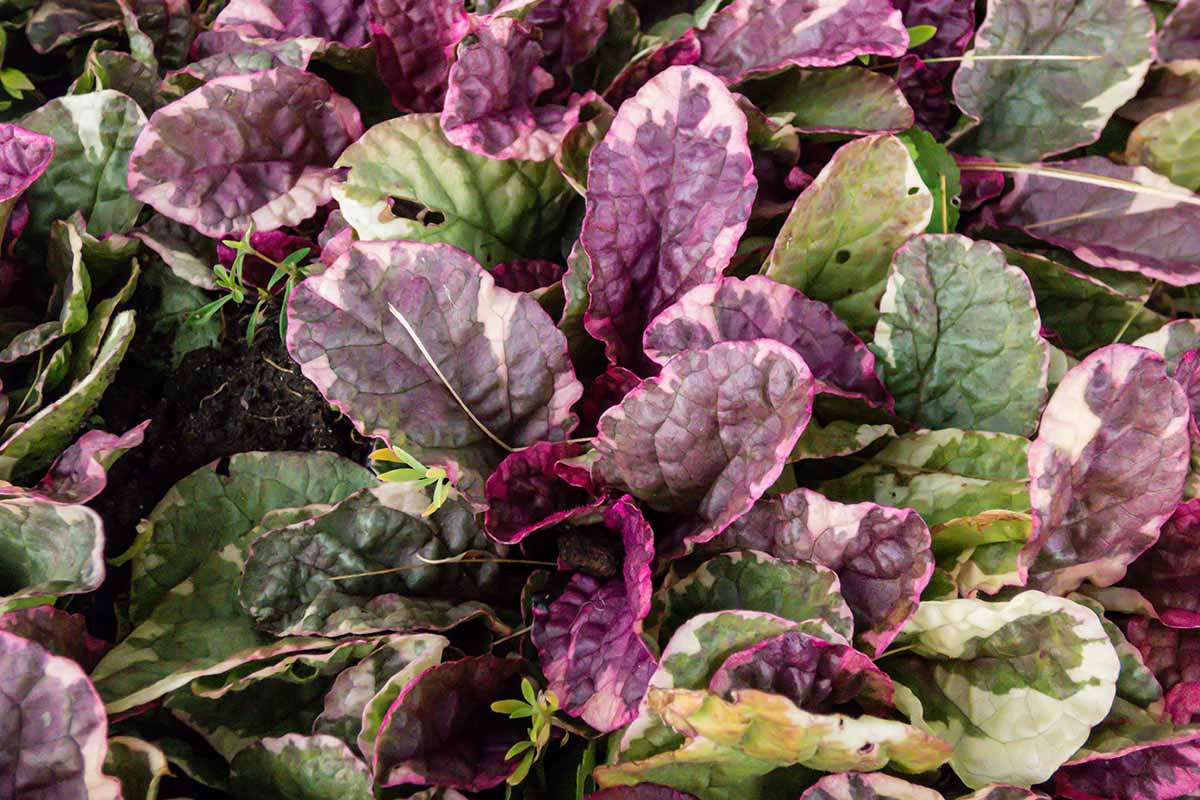
Ajuga reptans ‘Multicolor’ boasts variegated foliage of bronze, cream, green, and pink, adding a ground layer of seasonal color throughout beds and borders, suppressing weed growth all year long.
11. Cotoneaster
Ground-covering, berry-bearing cotoneaster, Cotoneaster horizontalis, is a substantial addition to the understory plants in a fall garden display.
Suited to Zones 5 to 7, it reaches a height of two to three feet. We include it as a ground cover because of its horizontally spreading growth habit.
Autumn foliage is red-purple with eye-catching bright red berries. Mass plants in problem areas like hillsides to inhibit erosion and avoid having to mow.
Cranberry cotoneaster, Cotoneaster apiculatus, grows in Zones 4 to 7. Mature plants are two to three feet tall with red and purple foliage and bright red berries.
Plants are available from Nature Hills.
Learn more about growing cotoneaster here.
12. Sedum
Sedum, Sedum spp., is a genus of succulents that grow in Zones ranging from 3 to 10, depending upon your chosen type. The heights are just as variable, between three and 24 inches, depending on the variety.
Foliage colors include maroon, pink, purple, and yellow-green for a bright weed-suppressing carpet of color.
The plants have shallow roots, making them suitable companion plants for bulbs. Small-statured varieties, like S. album ‘Coral Carpet,’ are suited to ground cover cultivation.
Taller varieties, like ‘Autumn Joy,’ (reclassified into the Hylotelephium genus) have flattened corymb-style flowers that make a stunning mid-rise swath of color through borders.
Rose deepens to russet for rich seasonal color. Mature heights are 18 to 24 inches in Zones 3 to 9.
‘Autumn Joy’ is available from Nature Hills.
See our sedum growing guide for more information.
Ornamental Grasses
Grasses and sedges add color and movement to the landscape with their loose, feathery inflorescences or flower stalks that sway in the breeze and run to seed as the growing season draws to a close.
13. Pink Muhly Grass
Although not what you might typically call a fall color, pink muhly grass, Muhlenbergia capillaris, definitely adds color to the late summer to fall landscape with cotton-candy-like inflorescences that deepen to gray-purple as they run to seed.
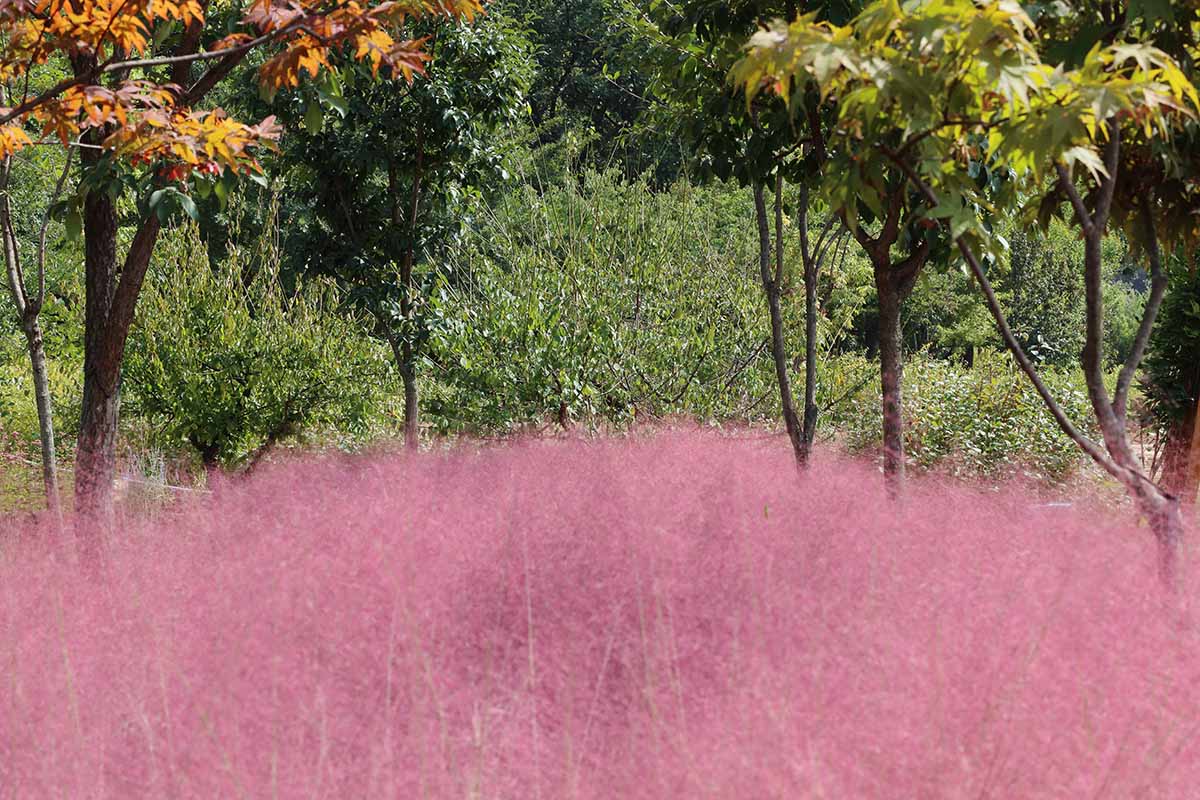
Suited to cultivation in Zones 5 to 9, multiple plants with their fountain-like form make a carefree informal hedge.
Individual clumps make stand-out specimens alone or in mixed groupings. Pair with pink, purple, and white seasonal options.
Learn more about ornamental grasses in our guide.
14. Sedge
Sedge (Carex spp.) is in the Cyperaceae family of grass-like plants with unique triangular blades, inflorescences, and an upright to arching growth habit.
Colors include green, orange, red, and yellow.
There are sedges for every Zone from 2 to 10 and a wide variety of species and cultivars that grow to heights of four to 60 inches.
Use this ornamental grass-like plant as a stand-alone specimen, companion to shrubs of similar stature in a mixed grouping, or mass plant for an informal perimeter privacy hedge.
Carex morrowii ‘Everglow’ in the EverColor® series has orange and green striped foliage with spiky brown seed heads.
Suited to Zones 6 to 9, it achieves mature heights of 15 to 18 inches.
‘Everglow’ is available from Nature Hills Nursery.
See our guide to growing sedge for details.
15. Switchgrass
Common switchgrass, Panicum virgatum, grows in Zones 5 to 9 and tops out at three to six feet.
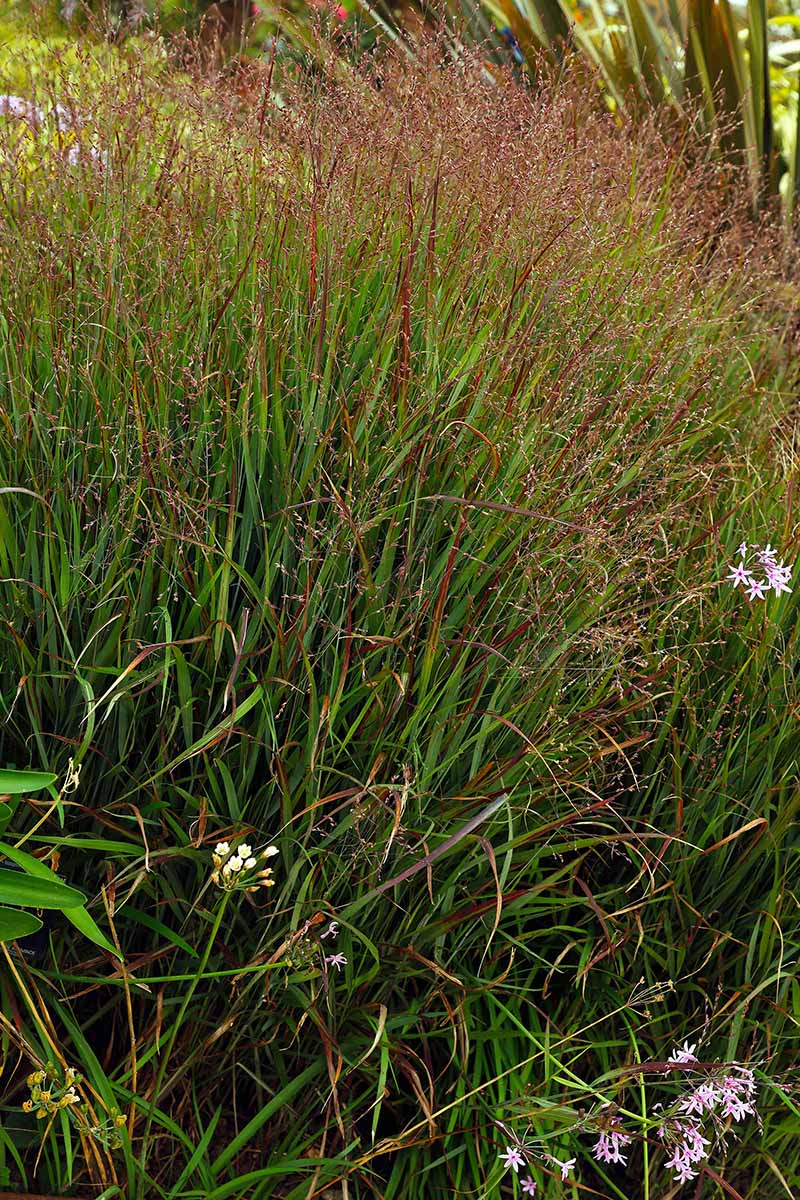
Its fountain-like shape is light and airy, with a mass of flowering inflorescences with a subtle pink-purple haze that runs to gold-brown seeds in the fall.
This ornamental grass is suited to informal hedging or specimen planting. It is also an excellent back-of-bed anchor plant for lower-profile flora.
Perennials
Late-season perennials have long been my go-to sources of fall color.
They add green foliage to the summer garden, biding their time until they burst into bloom as their companions wane.
16. Aster
Daisy-like asters (Aster, Doellingeria, Eurybia, Inonactis, and Symphyotrichum spp.) are shrubby plants that range in height from eight to 36 inches, depending on the species.
Asters bloom in shades of blue, pink, purple, or white. They grow in Zones 4 to 8.
Often called Michaelmas daisies, they produce copious quantities of small blooms from late summer to autumn.
Give them room to roam in mass-planted drifts and meadows, and add them to cottage, cutting, and pollinator gardens.
Symphyotrichum novae-angliae ‘Purple Dome’ are bright purple New England asters for Zones 4 to 9.
‘Purple Dome’ New England Asters
These reach mature heights of 18 to 24 inches with exceptional flowers that measure an inch and a half across.
‘Purple Dome’ asters are available from Burpee.
Read more about growing asters here.
17. Chrysanthemum
Chrysanthemums, Chrysanthemum spp., are suited to Zones 5 to 9, with some hardy to Zone 4, where they bloom through the fall to the first frost.
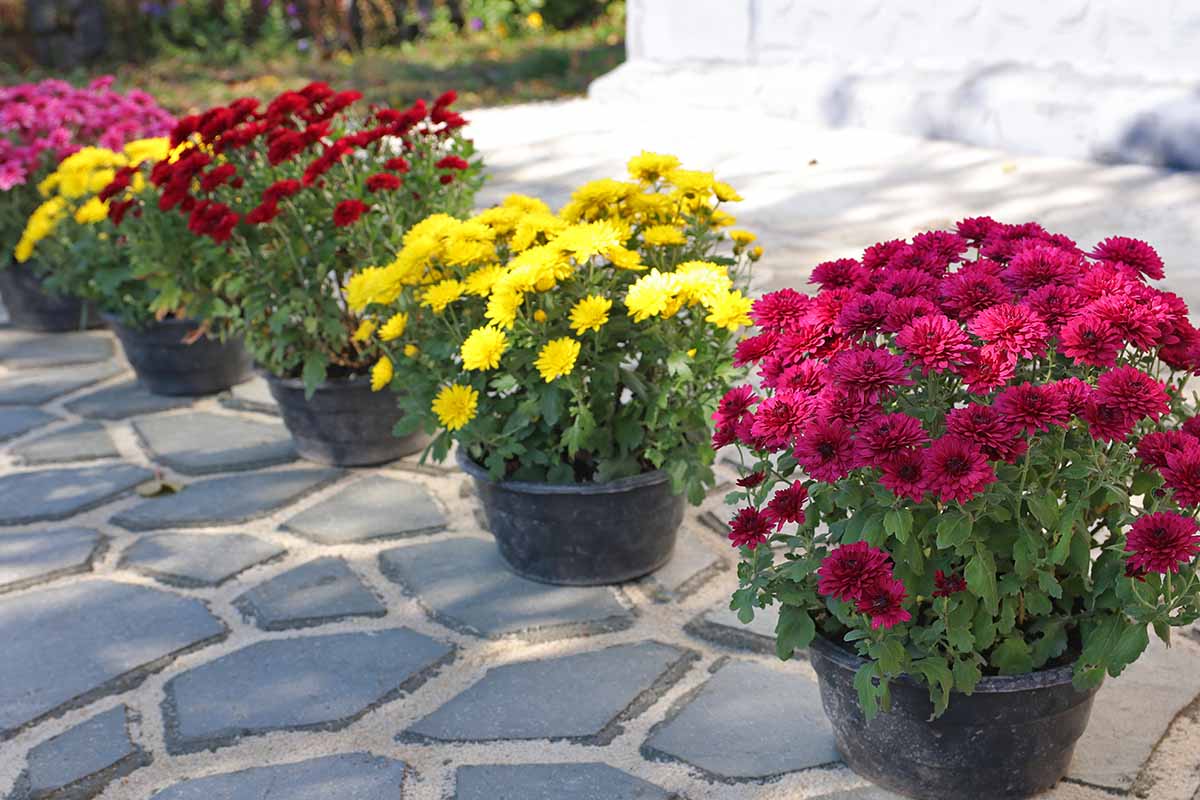
Nurseries carry potted mums in shades of orange, lavender, purple, russet, yellow, and white for instant decor.
Hardy or garden mums are perennial. Florist mums are annuals. Check with the seller to determine which you are getting.
Decorate the front porch rail or line the steps with potted annual varieties. Transplant hardy types into the garden beside fading perennials or in the spaces left by annuals that have already finished.
Use one or more colors to create borders along the walkway to your front entry.
Our guide to growing chrysanthemums has all you need to know.
18. Montauk Daisy
Another favorite, the Montauk daisy, Nipponanthemum nipponicum, blooms in the fall when you give it a Chelsea Chop in the spring.
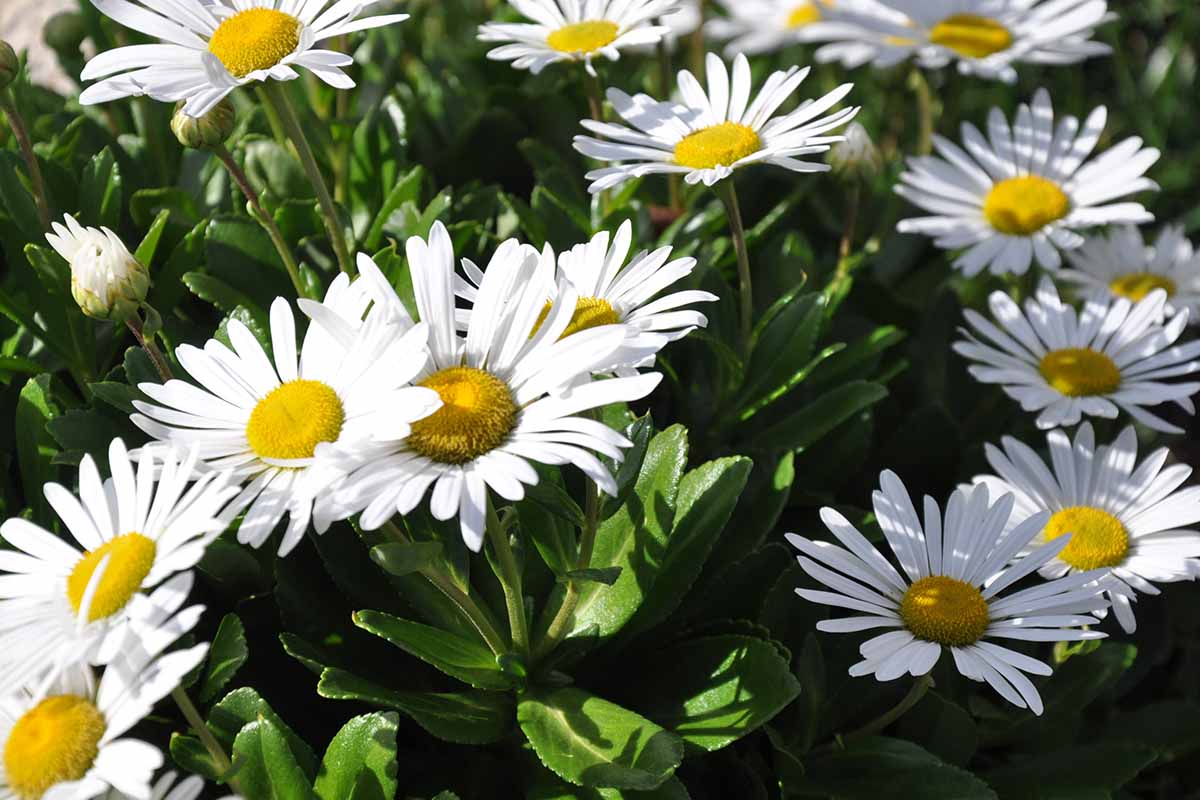
Grow it in Zones 5 to 9. It’s a classic daisy with crisp white rays and yellow centers.
Mature heights are 18 to 36 inches. With early pruning, compact plants are well-behaved in beds and borders alongside earlier blooming annuals and perennials like black-eyed Susans and coneflowers.
See our guide to growing Montauk daisies for cultivation details.
Shrubs
Shrubs are more challenging to pop into an existing landscape than flowers.
However, if you need to replace a shrub, consider those with fall colors to maximize your investment and build a seasonal color scheme.
19. Burning Bush
The burning bush is controversial because the non-native species, Euonymus alatus, is classified as invasive across approximately half of the US.
However, for those readers who live where it is not banned, including our international audience, it adds irresistible scarlet color and bright red berries to the late-season landscape.
E. alatus grows in Zones 4 to 8 to mature heights of 15 to 20 feet.
The alternative is the native burning bush, E. atropurpureus, that thrives in Zones 3 to 7 and reaches heights of 12 to 20 feet. Its foliage is a dull shade of red, but it also sports bright red berries.
Tall and dwarf species work as foundation plantings, stand-alone specimens, and formal or informal hedges. They look attractive in mixed shrub groupings.
E. alatus ‘Odom,’ aka Little Moses™ burning bush, is a dwarf variety for Zones 4 to 9 that reaches a mature height of 30 to 36 inches and displays bright red foliage.
Little Moses™ burning bush is available from Nature Hills.
See our guide to growing burning bushes for more information.
20. Fothergilla
Fothergilla, Fothergilla spp., is available in two types. Large fothergilla, F. major, is suited to Zones 4 to 8 and grows between four and 15 feet tall.
Dwarf fothergilla, F. gardenii, grows in Zones 5 to 9 and tops out at three to six feet. Fall foliage colors include bright orange, red, and yellow.
Large shrubs make excellent property perimeter plantings and informal privacy hedges.
Dwarf types are suited to foundation planting, low hedgerows, standalone specimens in large beds, and mixed dwarf shrub groupings.
Dwarf Beaver Creek Fothergilla
Dwarf Beaver Creek fothergilla, F. gardenii ‘Klmtwo,’ grows in Zones 5 to 8 and reaches mature heights of two to three feet.
Fall color is predominantly red with purple, orange, and yellow highlights.
Dwarf Beaver Creek fothergilla is available from Nature Hills.
21. Oakleaf Hydrangea
Oakleaf hydrangea, Hydrangea quercifolia, grows in Zones 5 to 9. Heights vary from two to 12 feet, depending upon the variety. Oak-like leaves turn red and shade to burgundy in the fall.
Best uses include mass planting in the shady understory beneath deciduous trees, foundation planting, standalone specimen use, or mixed bed groupings.
H. quercifolia ‘Alice’ is suited to Zones 5 to 9. Mature heights are eight to 12 feet tall and the fall foliage is red and purple.
‘Alice’ oakleaf hydrangea is available from Nature Hills.
See our guide to growing oakleaf hydrangea for more information.
Trees
Trees are the most significant plant investments in an outdoor living space, and require much forethought before installation.
As with shrubs, when selecting a new tree, consider fall color before making a selection.
22. Flowering Dogwood
Flowering dogwood, Cornus florida, grows in Zones 5 to 9. Mature heights are 15 to 35 feet.
Red to reddish-purple foliage and bright red berries make it a landscape focal point as the weather turns cooler.
As a native species, flowering dogwood is a valuable addition to the outdoor living space that attracts local birds and wildlife, such as woodland perimeters, bird gardens, and cottage garden settings.
Pink flowering dogwood, C. florida var. ruba, is suited to Zones 5 to 9 and reaches mature heights of 15 to 25 feet. Bright red berries and crimson foliage are a standout attraction.
Pink flowering dogwood is available from Nature Hills.
Read more in our guide to growing flowering dogwood trees.
23. Redbud
Redbud, Cercis spp., grows in Zones 4 to 10. Its heart-shaped leaves turn yellow as the days grow shorter.
Redbuds rise as tall as 30 feet. Use them as stand-alone specimens or in drifts with understory plantings that prefer dappled shade.
Suited to Zones 4 to 9, native Eastern redbud (C. canadensis) matures to heights of 20 to 30 feet. Leaves shade to a mellow harvest yellow.
Native Eastern redbud is available from Nature Hills.
You’ll find more information in our guide to growing redbud trees.
24. Red Maple
Maple trees, Acer spp., grow in Zones ranging from 2 to 10, depending on the species.
They may be dwarf or full size, growing up to 150 feet tall. The red maple, A. rubrum, is suited to Zones 3 to 9 and matures to a height of 40 to 70 feet.
The orange-red foliage is stunning in the autumn landscape. Plant as a stand-alone specimen or as a dramatic stand of multiple trees.
Red Pointe® red maple, Acer rubrum ‘Frank Jr.,’ is suited to Zones 5 to 9 and achieves mature heights of 40 to 45 feet. It has an upright, teardrop shape and bright red fall foliage.
Red Pointe® red maple is available from Nature Hills.
For detailed cultivation instructions, see our guide to growing red maple trees.
Vines
Annual or perennial vines that creep and climb take up little ground space if you train them up a trellis or along a fence, making them reasonable additions to existing landscapes.
25. Crimson Glory Vine
Crimson glory vine, Vitis coignetiae, is an ornamental grape vine that grows in Zones 5 to 9 and reaches lengths of 30 to 60 feet.
Its heart-shaped leaves turn bright red as the growing season draws to a close. Purplish-black berries accent the brilliant foliage.
Start a crimson glory vine from seed and show it to best advantage by training it up and over an arbor, up a trellis, or along a fence.
Crimson glory vine seeds are available from CZ Grain via Walmart.
26. Morning Glory
Annual morning glory, Ipomoea purpurea, grows quickly from seed with flowers available in shades of blue, pink, violet, and white.
It blooms from summer to frost and is suited to Zones 2 to 11.
Purple morning glories play well with yellow mums and purple and yellow pansies. If you allow the morning glories to grow over a fence or trellis, you can pop potted blooms in front of them for an instant garden change-up.
Mixed magenta and violet morning glories are at home in Zones 2 to 11 and make a striking impression all season long.
Morning Glory Mixed Magenta and Violet
Mixed magenta and violet morning glory seeds are available from True Leaf Market.
Our morning glory growing guide has detailed information.
27. Virginia Creeper
With its deep blue berries and scarlet and orange foliage, Virginia creeper, Parthenocissus quinquefolia, is a rustic roaming vine with the signature fiery foliage of fall. It grows in Zones 3 to 9.
Virginia creeper achieves mature heights of 30 to 50 feet. And as if the vibrant leaves weren’t enough, dusky, deep blue berries provide an added attraction.
Train vigorous Virginia creeper over arbors, fences, and trellises to showcase dramatic masses of color.
Red Wall® virginia creeper, P. quinquefolia ‘Troki,’ is suited to Zones 3 to 9 and reaches lengths of 30 to 50 feet. The fall foliage is bright red.
Red Wall® virginia creeper is available from Nature Hills.
See our guide to growing Virginia creeper for details.
Build in the Bold
When you design an outdoor living space that includes late-blooming flowers, berries, and striking foliage, a declining summer scene becomes a brilliant encore performance.
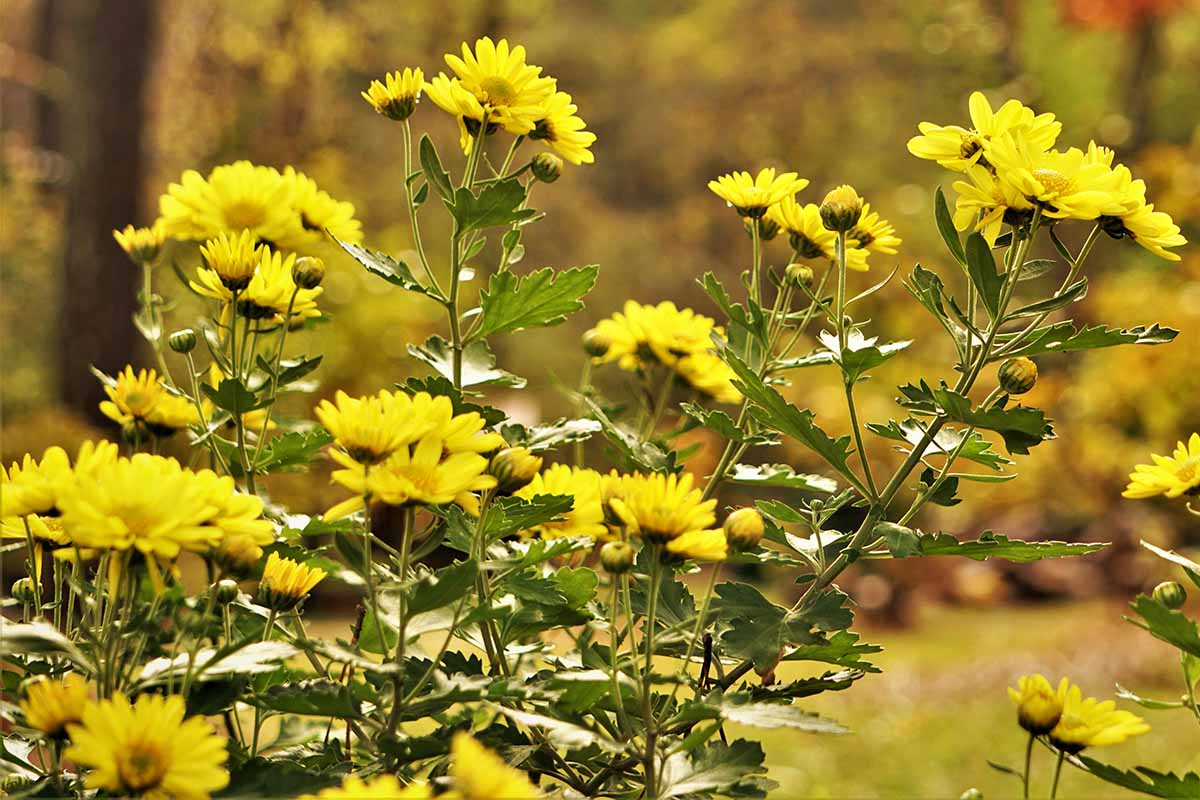
If you add to an existing design scheme, remember that shallow-rooted flora, like pansies and sedum, grow well in the soil above spring-flowering bulbs.
Many plants grow well in containers that are easy to place in beds, borders, and entryways for an instant makeover.
Vines afforded a fence or trellis for climbing take up little added ground space in established gardens.
And if you are in the market for new shrubs or trees, consider the color of their autumn foliage before making selections.
It’s time to jazz up your fall landscape!
A bold color palette bridging the gap between summer and winter refreshes the garden and the gardener who enjoys the view. What will you add to your garden to bring the color this autumn? Let us know in the comments below.
And for more ideas and tips for your fall garden, be sure to check out these helpful guides next:

